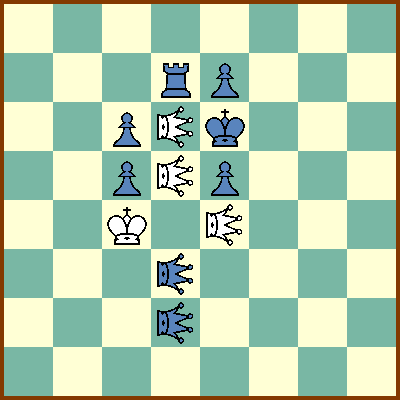Piececlopedia: Soucie
Historical notes
The Soucie was invented by Benjamin Good in 1998. It is named after Claude Soucie, the inventor of the game Lines-of-Action. Lines-of-Action is the original source of inspiration for the Soucie.The piece was originally named the Loa (which is the abbreviation used for line-of-action on Richard's Play-by-eMail Server). In January of 1999, Good emailed David Brown, then one of the editors for Strategems, a Chess problem magazine, about the piece. Brown made two suggestions: the first was to change the name, the second was a slight alteration of the piece's movement.
After exploring several possibilities, the Soucie was agreed upon as the piece's new name. The movement change was to allow the Soucie to jump over enemy pieces as well as friendly ones. Originally, the Soucie could jump over friendly pieces but not enemy pieces -- this restriction came from Line-of-Action, where a major element of the game's strategy is blocking your opponent's pieces with your own. Brown thought this was an arbitrary and unnecessary limitation for the piece in the chess problem world, and it was agreed that the Soucie could leap over pieces of both sides.
In April of 1999, the first published chess problem (see below) using the Soucie appeared in Strategems issue 6.
Movement
The Soucie can move in any orthogonal or diagonal direction. When it moves, it moves exactly the same number of squares as the number of pieces, including the Soucie, on the rank, file, or diagonal that it is moving along. The Soucie can leap over both friendly pieces and enemy pieces. If the Soucie lands on an enemy piece, it captures that piece.Soucie Helpstalemate Problem
The diagram below is the first ever published problem using the Soucie. It appeared in 1999 in StrateGems issue 6. The solution appeared in SG8. The problem has not been computer-tested for errors.
Movement examples:
The Soucie on d6 could move: to a3 (3 men on the a3-f8 diagonal), to c7
or e5 (1 man on the b8-h2 diagonal), a6 or g6 (3 men on the 6th rank),
or to d1 (5 men on the d-file). Note that e:d6? would be an illegal
self-check from the Soucie on e4 (as there are now only 2 men on the
file), as would 1...wKb3? from the Soucie on d3.
Benjamin Good
1999 StrateGems - Commended
H=4

Remarks
The Soucie was conceived as a problem piece. Unfortunately, since the publication of the first problem, no others have appeared. It is probably less useful as a game piece, where its movement can easily be affected by enemy pieces.
This is an item in the Piececlopedia: an overview of different (fairy) chess pieces.
Written by Benjamin C Good.
WWW page created: September 14, 1998.
WWW page updated: June 28, 2002.